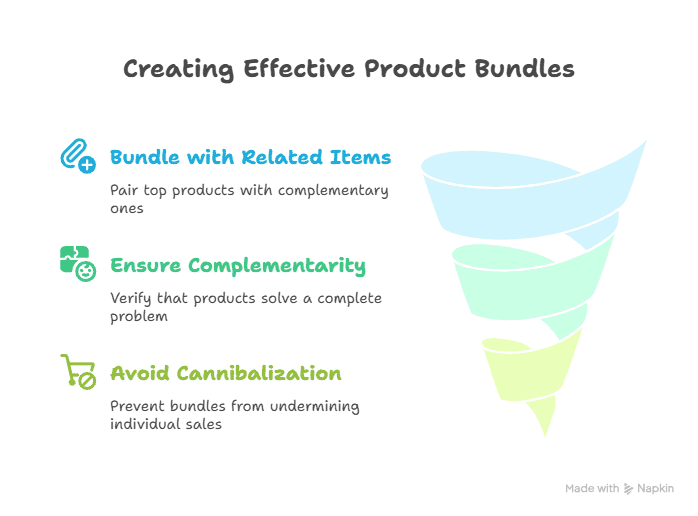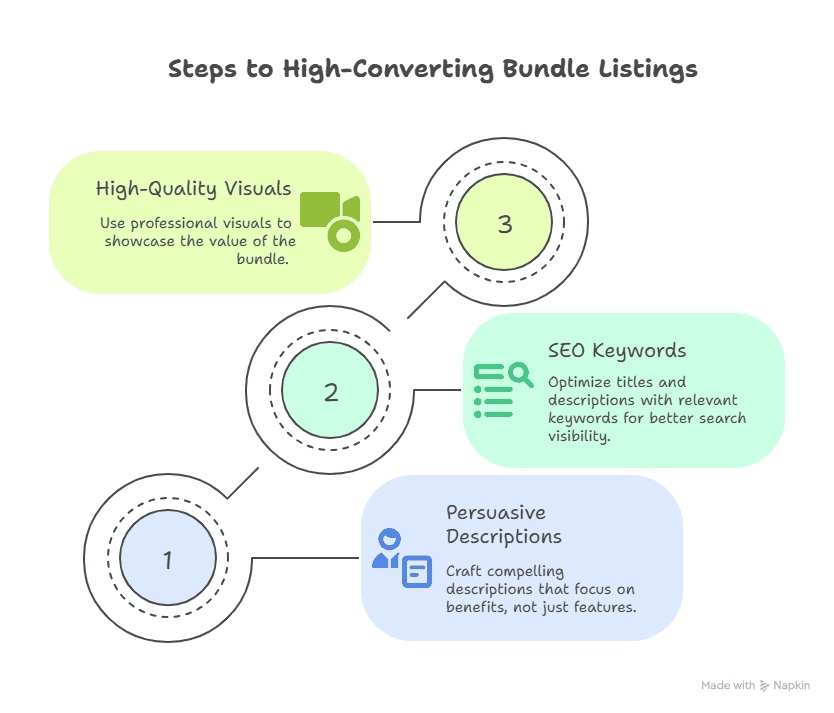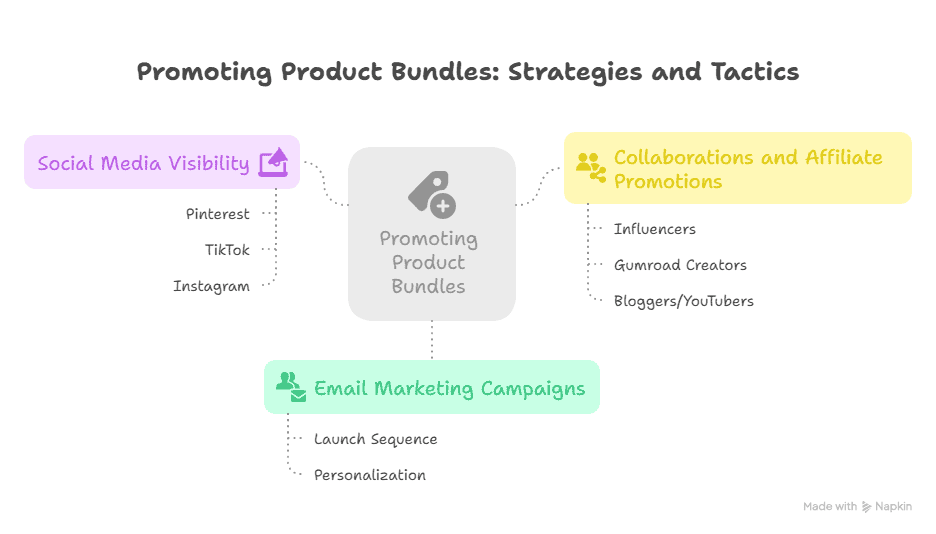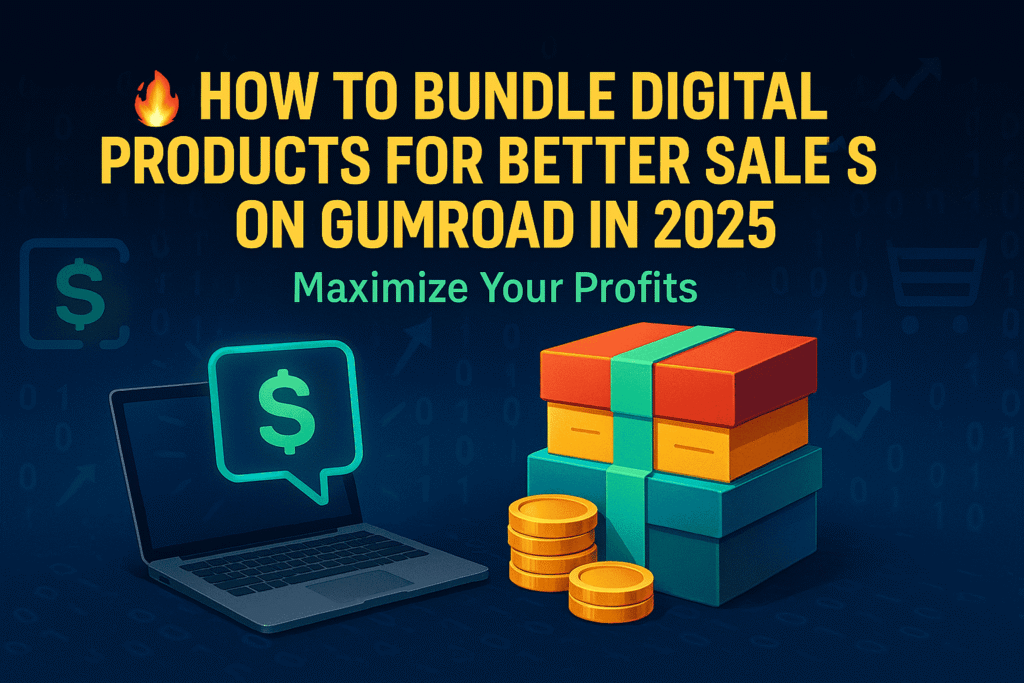Table of Contents
Love this post? Share it!
Introduction
In today’s fast-paced digital marketplace, simply offering great products isn’t enough—you also need to sell them in smart ways. That’s where product bundling comes in. Bundling digital products isn’t just a clever pricing trick; it’s a strategic move that can significantly boost your sales, increase perceived value, and help you stand out in a crowded platform like Gumroad. Whether you’re selling eBooks, templates, courses, or digital art, learning how to package them together can turn casual browsers into enthusiastic buyers.
Let’s dive into how you can master the art of digital product bundling and turn your Gumroad store into a sales machine.
What is Product Bundling?
Bundling Digital Products is not only a strategy but also a way to optimize your sales approach. As you create bundles of Digital Products, consider how each product complements the others and enhances the overall value to your customers.
Mastering the art of bundling Digital Products can lead to significant increases in sales and customer satisfaction.
Product bundling is the practice of selling two or more related Digital Products together as a single package—usually at a discounted price. Instead of selling each Digital Product individually, you offer a curated set that delivers more value to the customer in one go. For example, instead of selling a social media content calendar and a Canva template kit separately, you might bundle them into a ‘Digital Products Starter Pack’ and sell them together at a lower total price.
The concept is simple, but the results can be powerful. Bundling helps your customers feel like they’re getting more for their money—and helps you move more products in fewer transactions.
Why Bundling Digital Products Boosts Sales on Gumroad
Promoting your bundles of Digital Products can enhance your reach and boost sales significantly.
Bundling works on Gumroad for a few key reasons. First, it creates an irresistible value proposition. When a buyer sees that they can get three or four products for slightly more than the price of one, the perceived value skyrockets. It also reduces decision fatigue—rather than picking and choosing, they get everything they need in one purchase.
On Gumroad, where competition is fierce and attention spans are short, bundling helps you capture interest faster and close more sales. It also increases your average order value (AOV), allowing you to earn more per transaction without needing to constantly hunt down new customers. Simply put: bundles are a win-win.
Displaying multiple Digital Products in a bundle can make the purchase decision easier for customers.
Consider how bundling Digital Products can enhance your offering strategy on platforms like Gumroad.
Part 1: Understanding the Power of Bundling
1.1 What Makes Bundles Attractive to Buyers
Buyers love bundles because they simplify the decision-making process and stretch their dollar. When someone is faced with multiple related products, it’s easy to feel overwhelmed. But a thoughtfully packaged bundle removes the guesswork. Instead of choosing, the buyer gets a complete solution in one click.
There’s also a subtle sense of exclusivity and urgency that can be built into a bundle. When a customer sees a “limited-time offer” or a “complete toolkit,” they feel like they’re getting in on something special—and that makes them more likely to buy.
When bundling Digital Products, it’s crucial to ensure that the items not only sell well individually but also complement each other effectively.
1.2 Psychological Pricing: The Value Perception Advantage
Bundling taps into a psychological pricing principle: people love getting a deal. Even if your bundle only saves them a few dollars compared to buying each product separately, the perception of added value is what matters. It feels like a bonus.
Let’s say you offer three digital products worth $30 each. Selling them individually totals $90, but you offer the bundle for $59. That $31 “savings” feels like a win—even if the customer didn’t plan to buy all three originally. The sense of saving money is powerful enough to trigger action.
1.3 Types of Bundles: Pure vs. Mixed
There are two main types of product bundles to consider:
- Pure Bundles: These are collections only available as a bundle. Customers can’t buy the individual items separately. This works well for exclusive deals or brand-new launches.
- Mixed Bundles: In this case, each product is also available for individual purchase. The bundle is simply a value-packed alternative. This gives customers the freedom to choose—and often leads them to pick the bundle because it offers more bang for their buck.
Both types can work on Gumroad, but choosing the right one depends on your overall sales strategy and how flexible you want to be with your offerings.
Part 2: Choosing the Right Products to Bundle
2.1 Identifying Your Best-Selling Digital Products
Start with your strongest performers. Look at your Gumroad analytics to see which products consistently get sales or traffic. These are your breadwinners—the digital goods that already have audience trust and interest.
Bundling them with related, lower-performing items can elevate underperformers while maintaining the credibility of your top products. It’s like putting a hit single on a playlist with newer songs—the popularity lifts the rest.
2.2 Complementary Products: What Works Well Together
The best bundles solve a complete problem. That means you should group products that naturally fit together. For example:
- An eBook about freelancing + invoice templates + a freelance contract PDF
- A video editing course + YouTube thumbnail templates + royalty-free music pack
Think about the buyer’s journey. What tools, resources, or content would they logically use together? When a bundle makes sense, it sells itself.
2.3 Avoiding Cannibalization: When Not to Bundle
Bundling can backfire if it undercuts your existing sales. For example, if you discount your best-selling product too heavily in a bundle, customers may hold off on buying it alone, waiting for the bundle instead.
To avoid this, don’t bundle high-demand products unless the combined offer delivers enough additional value to justify the deal. Also, avoid putting the same product in too many different bundles—it can confuse buyers and reduce urgency.
Part 3: Planning and Structuring Your Bundles

3.1 Bundle Size: How Many Products is Too Many?
More isn’t always better. A good rule of thumb is to bundle 2–5 products together. Beyond that, the offer can feel bloated or overwhelming. Buyers may not see the value in each item if the list is too long.
Focus on quality and coherence over quantity. If you have a large catalog, consider offering multiple smaller bundles instead of one giant one.
3.2 Product Tiering: Basic, Standard, and Premium Bundles
Creating tiered bundles is a fantastic way to appeal to different buyer segments:
- Basic Bundle: Offers essential items at an entry-level price.
- Standard Bundle: Includes a mix of essential and bonus content.
- Premium Bundle: Contains everything plus extras like bonus templates, private access, or future updates.
This “good, better, best” model works beautifully on Gumroad and increases the chances of higher-priced sales while giving budget-conscious buyers a lower barrier to entry.
3.3 Creating Logical Product Groupings
Your bundle should tell a story. Think in terms of themes or outcomes. For example:
- “Launch Your First Course” bundle: course planner, outline templates, video lesson guide
- “Start a Side Hustle Kit”: niche idea generator, business name checklist, branding templates
When products flow together naturally, the buyer sees the benefit instantly—and that leads to more conversions.
With your Digital Products strategically bundled, you can attract more customers looking for comprehensive solutions.
Part 4: Pricing Your Bundles for Maximum Revenue
4.1 How to Calculate Bundle Discounts
Pricing your bundle strategically is essential—you want to offer a deal that’s appealing to customers but still profitable for you. A good starting point is offering a 20% to 40% discount compared to the total price of the individual items. This creates a clear incentive without devaluing your products.
Here’s a simple formula to follow:
Bundle Price = (Total Individual Prices) x (1 – Discount Percentage)
Let’s say your three products cost $25, $30, and $20. That’s $75 total. A 30% discount brings the bundle price to $52.50—a noticeable savings that still rewards you with a solid profit.
Test different discount levels, and pay attention to your profit margins. Pricing too low might increase sales but reduce your revenue in the long run.
4.2 Psychological Pricing Strategies That Work
Psychological pricing is all about making your offer feel more valuable. Use these proven strategies to boost conversions:
- Charm pricing: Ending your price in .99 or .97 makes it feel cheaper (e.g., $29.99 instead of $30).
- Anchor pricing: Display the original combined price next to the bundle price (e.g., “Was $75, Now Only $52”).
- Decoy pricing: Offer multiple tiers where the mid-tier appears to offer the best value (e.g., Basic $29, Standard $52, Premium $89).
These small tweaks can dramatically increase your sales by helping buyers justify their purchase emotionally.
4.3 Offering Limited-Time or Launch-Only Pricing
Urgency sells. A limited-time offer adds a subtle pressure that can push a potential customer from “maybe later” to “I need this now.”
Use scarcity by:
- Launching your bundle with an introductory price for the first 48–72 hours
- Adding countdown timers or expiration dates in your emails or landing pages
- Promoting “only available this week” or “early-bird access” deals
After the limited window, you can either raise the price or remove certain bonuses, reinforcing the idea that early action is rewarded.
Part 5: Crafting High-Converting Bundle Listings on Gumroad

5.1 Writing Persuasive Product Descriptions
Your bundle description is where curiosity turns into conversion. Focus on benefits, not just features. Instead of listing what’s inside, explain what the buyer will achieve or solve with the bundle.
Structure your description like this:
- Hook: A strong opening sentence that addresses a pain point or promise (“Struggling to grow on Instagram? This bundle will fix that.”)
- Breakdown: A list of what’s included
- Benefits: What they’ll gain or achieve
- CTA: A friendly push to buy (“Grab it now and start growing today!”)
Use short paragraphs, bullet points, and bold highlights for easy readability.
5.2 Using SEO Keywords in Your Bundle Title
If you want people to find your bundle organically, SEO matters—yes, even on Gumroad.
Include relevant keywords in your title and description. Think like your buyer:
- Instead of: “The Ultimate Kit”
- Try: “Freelance Starter Kit: Contracts, Invoice Templates & Business Planner”
Use keywords like:
- “Templates”
- “Toolkit”
- “Starter Pack”
- “[Your niche] Bundle” (e.g., Etsy Seller Bundle, Digital Planner Bundle)
This helps you show up in search both on Gumroad and Google.
5.3 High-Quality Visuals That Sell
Visuals are the first impression—make it count. Use professional-looking mockups that showcase the value inside your bundle. Don’t just use screenshots; create aesthetic, branded previews.
Tips:
- Use Canva to design clean product mockups
- Include text overlays like “Includes 12 Templates + Bonus Workbook”
- Stick to consistent colors and fonts that reflect your brand
If you can, include a short preview video or GIF that shows the product in action—it’s a powerful way to increase trust.
Part 6: Technical Setup on Gumroad
6.1 How to Create a Bundle on Gumroad Step-by-Step
Creating a bundle on Gumroad is simple, but here’s a step-by-step guide to keep you on track:
- Log into your Gumroad dashboard.
- Click “New Product” and choose “Digital Product.”
- Title your product and add a cover image.
- Under “Content,” upload all the files you want to include in the bundle.
- Add a detailed description and price.
- Customize the checkout page if desired.
- Click “Publish” when you’re ready.
Boom—your bundle is live and ready to make money.
6.2 Setting Up File Delivery & Access Permissions
Make sure your customers receive everything smoothly:
- For PDFs, templates, and docs: Upload directly or in a ZIP folder.
- For large files or videos: Use external links like Google Drive or Dropbox.
- Want to offer future updates? Enable “Send product updates” in settings.
Always test your checkout flow before launch to make sure the files are accessible and organized.
6.3 Managing Updates & Revisions Across Bundled Products
One of the perks of digital products is you can always improve them. When you update a product inside a bundle:
- Go to the product dashboard.
- Replace the outdated file with the new version.
- Use Gumroad’s “Update Buyers” feature to email past customers and let them know.
This not only boosts credibility but also encourages repeat customers who value that you keep your products fresh and relevant.
Part 7: Promoting Your Product Bundles

7.1 Email Marketing Campaigns for Bundle Launches
Your email list is a goldmine for bundle sales. Craft a 3–5 day launch sequence like this:
- Day 1: Announce the bundle + limited-time offer
- Day 2: Share testimonials or a sneak peek
- Day 3: Offer social proof (case studies or user success)
- Day 4: “Last chance” email with countdown urgency
- Day 5: Final reminder with strong CTA
Use subject lines that spark curiosity and urgency. Personalize the message as much as possible.
7.2 Leveraging Pinterest, TikTok & Instagram for Visibility
Social media is your bundle’s megaphone. Use different platforms for different styles:
- Pinterest: Pin high-quality vertical mockups with call-to-actions like “Pin now, grab later!”
- TikTok: Share 15–30 second videos showing what’s inside your bundle, or record a “day in the life” using the products
- Instagram: Post carousels showing bundle benefits, before/after results, or customer shoutouts
Always include a clear link in bio or description pointing to your Gumroad bundle.
7.3 Collaborations and Affiliate Promotions
You don’t have to do all the promotion alone. Reach out to:
- Influencers in your niche
- Fellow Gumroad creators
- Bloggers or YouTubers with aligned audiences
Offer them a commission through Gumroad’s built-in affiliate system. It’s a win-win: they promote your bundle, and you both make money.
You can also do bundle swaps—promote each other’s offers to expand your reach quickly without spending a dime.
As you create your bundles of Digital Products, remember to highlight their combined value to encourage buyers.
Part 8: Measuring and Optimizing Bundle Performance
8.1 Key Metrics to Track Bundle Success
After launching your digital product bundle on Gumroad, tracking its performance is crucial for ongoing success. Pay close attention to the following key metrics:
- Conversion Rate: How many people who visit your bundle page actually buy? A low rate may signal poor visuals, pricing, or copy.
- Revenue per Visitor: This tells you how much you’re earning from each visit and helps you judge the effectiveness of your marketing.
- Average Order Value (AOV): Bundles often raise your AOV. Monitor this to see how well your bundles are working.
- Refund Rate: A high rate might suggest misalignment between what’s promised and what’s delivered.
- Traffic Sources: Know where your buyers are coming from so you can focus your efforts on the right platforms.
Regularly reviewing these stats allows you to fine-tune your strategy and double down on what works.
8.2 Split Testing Different Bundle Versions
Split testing (A/B testing) isn’t just for big companies. You can test various elements of your bundle listing to see which performs best:
- Titles: Try different keywords or emotional hooks.
- Images: Test clean vs. bold designs.
- Prices: See how a $29 bundle compares to $34.99.
- Descriptions: Short vs. long, benefit-focused vs. feature-focused.
Run tests one change at a time, measure performance over 1–2 weeks, and go with what converts best. Gumroad doesn’t offer native A/B testing, but you can clone your product page or run variations through different traffic channels.
8.3 Collecting and Leveraging Customer Feedback
Customer feedback is pure gold. Here’s how to get it—and use it:
- Ask for reviews in your post-purchase emails.
- Use a simple Google Form or Typeform to gather feedback on what they loved or found confusing.
- Look for patterns: Are buyers consistently asking for a specific feature? Are they confused about how to use something?
Once you have insights, act on them. Update your bundle, add new elements, or clarify your messaging. Then let your audience know—this shows you care and builds trust.
Part 9: Scaling Your Success with Automation
9.1 Using Zapier to Automate Sales Funnels
Automation is your best friend when it comes to scaling. With Zapier, you can connect Gumroad to dozens of other tools to streamline your workflows:
- Add buyers to your email list automatically
- Send personalized welcome emails through platforms like ConvertKit or MailerLite
- Trigger course enrollments, deliver bonus content, or start onboarding sequences
Set it up once, and your business keeps running—even while you sleep.
9.2 Integrating Upsells & Downsells with Your Bundles
Once someone buys a bundle, that’s the perfect time to offer something else. Use Gumroad’s product recommendations to suggest:
- Upsells: A premium version, coaching session, or exclusive training
- Downsells: A lower-cost mini product for those who abandoned the cart or didn’t buy
These extra offers can significantly boost your earnings without extra marketing costs.
9.3 Repurposing Content for Future Bundle Offers
You don’t need to reinvent the wheel every time. Repurpose and repackage your existing content:
- Combine items from older bundles into a “Best of” collection
- Turn parts of a course into a starter kit
- Group seasonal or event-based products into limited-time offers
This strategy keeps your store fresh and exciting—while saving you time and energy.
Conclusion
Final Thoughts: Bundling as a Smart Long-Term Strategy
Digital product bundling isn’t just a sales tactic—it’s a sustainable business strategy. When done right, it provides immense value to your audience, increases your earnings per transaction, and strengthens your brand’s authority on platforms like Gumroad.
As your product library grows, so do your opportunities to bundle smarter, test new angles, and scale your digital income. Don’t see bundling as a one-time event—it’s a flexible, repeatable method to keep your content working for you.
Action Steps to Get Started Today
- Pick 2–4 related digital products from your Gumroad store.
- Group them into a value-driven bundle with a compelling name.
- Design a clean cover image using Canva or another tool.
- Write a benefit-focused description and publish your listing.
- Promote it via email and social media with urgency.
- Monitor the performance, tweak, and test as you grow.
In just a few hours, you can launch a bundle that boosts sales and delivers real value.
Frequently Asked Questions (FAQs)
Q1: What types of digital products are best suited for bundling?
Products that solve related problems or are often used together work best—think templates, toolkits, planners, guides, courses, and workbooks. If they serve the same audience, they likely bundle well.
Q2: How often should I update or refresh my bundles?
Aim to refresh bundles every 3–6 months. Add new items, revise existing content, or rotate seasonal offers. This keeps your listings relevant and gives you something new to promote.
Q3: Can I bundle free and paid products together?
Yes! Adding a free product to a paid bundle increases perceived value. Just make sure the freebie complements the other products and doesn’t overwhelm the buyer with too much content.
Q4: Should I offer both individual products and bundles?
Absolutely. This gives customers the flexibility to choose what suits them. Many will opt for the bundle because of the value, but others may want only one product.
Q5: What if I want to sell the same product in multiple bundles?
Go for it—but be strategic. Ensure each bundle offers unique value or is targeted at a specific buyer need. Just don’t flood your store with too many overlapping options.

